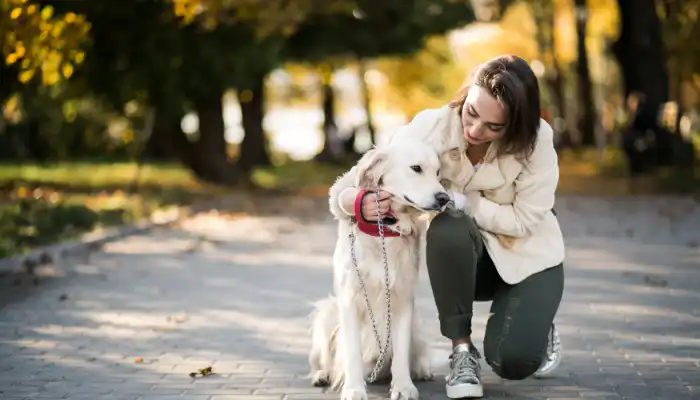Dogs are incredible creatures with unique ways of conveying their emotions. Although they do not use words, they perfectly express happiness, fear, and even remorse in their own ways. A common question among dog owners is, “What Is Sorry in Dog Language?”
While there are some dog translator tools available that you can use. But there are different ways to apologize to your little friend. We will look into how dogs go about apologizing, the signs they show, and how you should handle their attempts at reconciliation.

Understanding Dog Language
Before addressing “What Is Sorry in Dog Language?” question, one must learn about how dogs ‘speak’. Dogs use bodily movements, vocal sounds, and actions to express feeling. They do not have a way to verbally ‘apologize’, but they have many ways of seeking forgiveness.
Components of ‘Dog’ Language
- Body Language: When a dog’s tail wags, ears move up, and their body stands tall, these are speaks of joy.
- Facial Expressions: Dogs blink their eyes or lick their lips to convey waiting or submission.
- Vocalizations: Dogs can make a variety of sounds, including whining, barking, or growling.
- Behavioral Signs: Gestures such as rolling over or presenting a paw quickly to their human.
Knowing these forms of communication improves how students interpret a dog’s feelings. This boundless intellect deepens the relationship between a dog and its owner.
How Do Dogs Say Sorry?
So, “What Is Sorry in Dog Language?” Dogs don’t have a direct translation of the term “sorry,” but there are measures which dogs take to show remorse. Often these signs are faint and difficult to notice in real time.
Common Signs of a Dog Saying Sorry
- Turning Away From the Eyes: This can indicate an attempt to submit but also an attempt to avoid conflict.
- Licking or Nuzzling: This is suggestive of wanting affection and some reassurance.
- Crouching or Tucking the Tail: This is a submissive stance and shows acceptance of guilt for the offense.
- Offering a Toy or Treat: Some dogs gift items to seek reconciliation and goodwill.
These signs suggest that dogs have innate tendencies to apologize like humans.
Why Do Dogs Apologize?
There is unity among members of a pack of dogs, and so keeping the pack together is important. If they perceive that a fellow human or dog is angry, they will most likely try to adopt an apologetic attitude. Understanding “How Do Dogs Say Sorry?” can help in managing your dog well.
Reasons Explain Such Helpful Attitude
- Fear of A Fight: Dogs are often too fearful of facing the aftermath which comes along with tension.
- Desire For Approval: They expect a response and affection from their owners.
- Instinctive Behavior: Apologizing stems from their pack behavior.
Every dog is capable of understanding their owner’s displeasure. Once you know the reasons behind a dog’s apology, you will be able to manage relations with your furry friend in a much more loving manner.
What To Do When You See Your Dog Apologizing
It is essential for you to note your dog when he displays apologetic behavior so that you can modify your dog’s behavior during such moments. This will help reinforce the desired actions.
- Stay Calm: Avoid yelling or scolding and allow your dog to calm down, as this will only make him more anxious.
- Offer Reassurance: Stroke them softly or talk to them in a soft soothing voice.
- Reward Good Behavior: Praise them or use treats to motivate them.
- Set Clear Boundaries: Make it clear what actions are wanted and which ones are not.
Misinterpreting Dog Apologies
While it is heart throbbing to envision your dog saying sorry, try not to puzzle out what your furry companion does too much. Dogs do not feel regret or shame the same way that we humans do. Moreover, their self-inflicted apology often accompanies the irritation of your tone or gestures.
- Guilt vs. Fear: Some might interpret fear of punishment as guilt.
- Learned Behavior: Dogs will repeat certain actions that have received a positive response in the past.
It helps prevent unwanted behavior in the future if guidance is offered after the dog has apologized Knowing about these misconceptions assists you in understanding the intentions and feelings of your dog accurately.
Strengthening Your Bond Through Understanding
With “What Is Sorry in Dog Language?”, you will improve your relationship with your canine friend. So long as he or she is making efforts to restore peace, accepting their apology assists in nurturing trust and respect.
Tips for Building a Stronger Bond
- Spend Quality Time Together: Play, walk, and cuddle with your dog regularly.
- Be Consistent: Use clear commands and reward good behavior.
- Learn Their Language: Pay attention to their body language and vocalizations.
With understanding, patience, and love as the foundation, the bond between you and your dog will grow stronger with each passing day, making every experience together special.
Conclusion
Your dogs will never say “sorry” as humans do, but they will certainly make up for it in one way or the other. Knowing what “What Is Sorry in Dog Language?” entails is key to enhancing your relationship and appreciating their unique communicative approach. When you notice your dog attempting to apologize next, be sure to meet them with affection and patience. After all, they are trying to make amends in ways they know how to.
